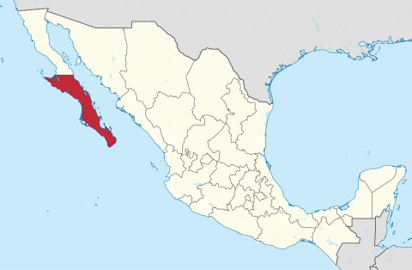Baja California Sur State

Traditionally based mostly on tourism, sport fishing, salt production, and mining, in 2012 the GDP of the state accounted for only 0.73% of the country's GDP, but grew 3.13% in comparison to the year prior. In 2013, this growth increased to 7.8%.Unemployment in 2013 was 5.1% with employment shifting away from agriculture and fishing to mining and industry (up 19.9%) and commerce (up 4.9%). Today, agriculture, fishing and forestry account for only 3.89% of the state GDP. Commercial species include tuna, sardines, anchovies, clams, snails, oysters, shark, lobsters, abalone, shrimp, and crabs, which are sold both nationally and internationally. Commercial fishing harvests lobster, shrimp, tuna, abalone, and clams. Major crops include garbanzo beans, sorghum, tomatoes, alfalfa, wheat, corn and green chili peppers. Livestock includes pigs, cattle, goats and chickens.
Mining, construction and utilities account for 26.61%. Mining includes plaster (mainly on the San Marcos Island), limestone (in Todos los Santos), phosphorus (in San Juan de La Costa and Adolfo LópezMateos, Comondú), copper (en Santa Rosalía), gold and silver (in the Triunfo-San Antonio mine), manganese (in Santa Rosalia and Punta Concepción Bay) and chrome (in San SebastiánVizcaíno and Magdalena bays). There are other minerals not yet routinely mined such as titanium, tungsten, and cobalt. There is some possibility of offshore hydrocarbons. The state also produces salt of 99.7% purity, mostly in the area around Guerrero Negro. There are two major industrial/technology parks: Parque Tecnológico BioHelis and Parque Industrial La Paz Sur. Traditional handcrafts can be found throughout the state and include articles made with seashells, palo chino, choya and cardon cactus. Baskets and other items are woven from palm fronds especially in el Triunfo Los Planes and the Sierra de los Dolores as well as fishing nets. Another important craft is leatherwork, especially the making of gear for horseback riding such as saddles, holsters and chaps along with belts and carrying bags. In addition, scrap metal is converted into various types of knives.
Commerce and services account for 69.5% of the GDP. La Paz was ranked 31st in Mexico by the World Bank and the International Finance Corporation in ease of doing business and 23rd as a place to open a business. Major activities of this type include hotel and food service (16.43%) and housing sales and rentals (10.67%), which along with other activities (17.65%) account for 58.37% of the total GDP.
The most dynamic aspect of the economy is tourism, with a number of natural resources which are apt for this purpose, such as the grey whales that come to the area to breed and the natural rock arch at Land's End is frequently photographed. Tourist attractions are divided into three regions: north (Guerrero Negro to Ciudad Constitución), center (La Paz to Todos Santos), and south (Los Barriles to Cabo San Lucas). Other attractions include deep sea fishing, golf, tennis, motorcycling, scuba diving and snorkeling, with windsurfing at Medano Beach and surfing at Todos Santos, Pescadero East Cape and Scorpion Bay.
Other important activities include fishing and fish farming, alternative energy production, mineral and salt extraction, film production, information and communication technologies, and biotechnology. Local fruits include dates, green papaya in syrup, along with guavas and pitahaya. Santa Rosalia is known for its production of breads.
GDP BAJA CALIFORNIA SUR $10 990 million of USD






